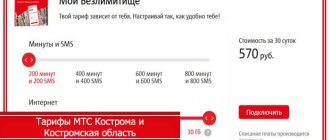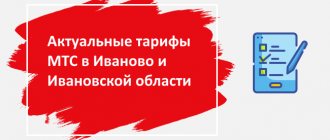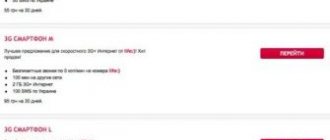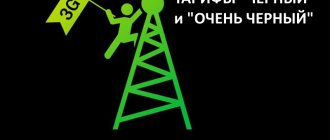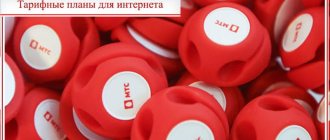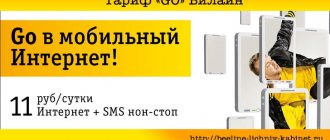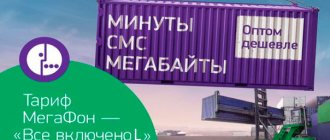In this article we have collected information for you about the so-called “data transmission by voice” in the MTS network. The text below will be useful if you are thinking about purchasing alarm, fire safety sensors, or communicating remotely with another device.
Description
The Internet of Things TP does not have a subscription fee. It is intended for corporate clients (organizations and individual entrepreneurs) using various IoT/M2M devices. This tariff is needed for those who use various sensors and telemetry devices that support communication via a cellular network.
Upon request for 100 rubles. a heat-resistant SIM card or SIM chip can be issued for RUR 235. A standard format SIM card is issued free of charge.
Let's consider the cost of basic services within the tariff:
- Mobile Internet – 1.5 rubles/MB, and when using a secure communication channel – 3.5 rubles/MB.
- Data transfer via the CSD protocol to Megafon subscribers is 1.4 rubles per minute, and to other operators – 3 rubles per minute.
- Outgoing short text messages to Megafon phones – 1.5 rubles/piece, and to numbers of third-party operators – 1.8 rubles.
The cost of calls using the CSD protocol within the region where the SIM card was purchased is given. For them, per-second billing is applied. To reduce costs, it is possible to purchase mobile Internet packages with a volume of 15-300 MB. You can purchase additional traffic packages with access to equipment health monitoring functionality. Internet packages with information transmission over a secure channel are also available.
The tariff is completely unsuitable for regular calls. An outgoing call in this category will cost at least 7 rubles per minute. Tariffing of traffic consumption is carried out rounded to 1 KB.
Tariff for foreign tourists – #Hello
SMS technology (SMS Tunnel function).
The SMS Tunnel function is easy to set up and provides a transparent data transmission channel without the need to first establish a connection. Restrictions on the use of this function are related to the features of SMS messaging. First, the average message delivery time is 8 seconds. Therefore, the method is not applicable for applications that are critical to such delays. Secondly, large-volume data (i.e., that does not fit into one SMS message) will be split into several messages. When testing modems, a situation repeatedly arose when the order in which messages were received differed from the order in which they were sent.
The maximum message size in the GSM standard is 140 bytes. Thus, when using 7-bit encoding (Latin alphabet and numbers), you can send messages up to 160 characters long. Therefore, it is strongly recommended not to send data packets whose length exceeds the volume of one SMS message: not only may pauses occur during data transmission, but the order in which SMS messages arrive at the receiving end may also change.
Among the possible applications of the SMS Tunnel mode, environmental monitoring, alarm and personnel warning systems should be highlighted: if a monitored parameter goes beyond the permissible value, the operator can receive a corresponding SMS message on his mobile phone. Short messages can also be used in managing systems like “ smart home": the operator can remotely control the temperature in the room, turn on the lighting, etc. In international transport systems, SMS messages are used to change the state of controlled road signs or display messages on text information boards.
The “Internet of Things for Business” tariff option is available for corporate clients who want to fix communication costs. It provides:
- unlimited Internet at a speed of 64 Kbps;
- unlimited traffic via NB-IoT protocol;
- equipment performance monitoring.
These capabilities are sufficient for various sensors and other telemetry devices. The cost of using the option is 100 rubles per month. Activation is available in the corporate client account. There is no connection fee.
Preparing iRZ modems for operation using CSD technology using the iRZ TestModem program.
Download and install the iRZ TestModem program for your version of the operating system. Next, run TestModem
and select your device from the list.
If you know the COM port number, you can specify it in the “ Port parameters”
“, otherwise the program will try to detect the modem on its own.
Click the " Get Started"
".
Once the status indicator turns green, go to the Settings
.
In the " Mode"
» select the interface speed.
It must match the speed of the equipment connected to the modem. As a rule, the standard speed of 9600 bps
.
Set the modem that will dial the telephone number to the “ Leader
” mode.
Set the modem that will accept incoming connections to the “ Slave
” mode.
Click the " Get Started
" button. After setup, the modem will be turned off and for further operation it will need to be rebooted by briefly turning off the power.
How to disable
The client can disable the “Internet of Things” option at any time through the business account on the operator’s website or with the help of a manager. To disable the tariff of the same name, just switch to another one or completely abandon the number in your personal account.
If the subscriber decides to completely stop using the company’s services, then he needs to terminate the contract. To do this, you need to contact the operator’s managers and send a written notification.
The Internet of Things tariff and option allows you to use various smart telemetry devices and sensors at no extra cost. But they are available only to corporate clients (legal entities and individual entrepreneurs). There are alternative solutions and tariff plans for individuals.
see also
| 1G | |
| 2G | |
| GSM/3GPP | HSCSD GPRS EDGE/EGPRS (UWC-136) |
| 3GPP2 family | CDMA2000 1X (TIA/EIA/IS-2000) 1X Advanced |
| Another | WiDEN |
Wikimedia Foundation. 2010.
See what “Circuit Switched Data” is in other dictionaries:
- Circuit Switched Data
— (CSD) is the original form of data transmission developed for the time division multiple access (TDMA) based mobile phone systems like Global System for Mobile Communications (GSM). CSD uses a single radio time slot to deliver 9.6 kbit/s data... ... Wikipedia
Circuit Switched Data
— (CSD) es la forma original de transmisión de datos desarrollada para los sistemas de telefonía móvil basados en el acceso múltiple por división de tiempo (TDMA) como el GSM. CSD usa un intervalo de tiempo (time slot) de radio individual para… … Wikipedia Español
Circuit Switched Data
— ist ein Übertragungsverfahren beim Mobilfunk, bei dem eine Datenverbindung vom Mobilfunktelefon zu einer (beliebigen) Gegenstelle hergestellt wird. Diese Verbindung ist mit einem einfachen Telefongespräch vergleichbar. Im Unterschied dazu werden… … Deutsch Wikipedia
Circuit Switched Data
— Pour les articles homonymes, voir CSD. Le Circuit Switched Data (CSD) est la forme originale de transfert de données développée pour les systèmes de telephone mobiles basés en technologie TDMA comme le GSM. Il a un fonctionnement similaire à… … Wikipédia en Français
circuit switched data
— A method for keeping the circuit open between users for the duration of the connection … IT glossary of terms, acronyms and abbreviations
High-Speed Circuit-Switched Data
— (HSCSD), is an enhancement to Circuit Switched Data, the original data transmission mechanism of the GSM mobile phone system, four times faster than GSM, with data rates up to 38.4 kbit/s.As with CSD, channel allocation is done in circuit... ... Wikipedia
High-Speed Circuit-Switched Data
— (HSCSD), es una mejora al mecanismo de transmisión de datos de GSM o circuit switched data (CSD). Fue aprobado por la ETSI en 1997 y fue desplegado por varios operadores de GSM en el mundo. HSCSD introduce dos modificaciones tecnológicas que… … Wikipedia Español
High Speed Circuit Switched Data
— (HSCSD) est une technologie dont le but est de fournir un débit plus élevé pour les applications nécessitant des transferts de données. Le GSM utilise le TDMA, c est à dire que le temps est divisé en slots (période donnée). En GSM, un mobile... ... Wikipédia en Français
In this article we have collected information for you about the so-called “data transmission by voice” in the MTS network. The text below will be useful if you are thinking about purchasing alarm, fire safety sensors, or communicating remotely with another device.
First, let's briefly tell you what kind of technology this is and why it is needed.
Circuit Switched Data (CSD) is a switched data transmission technology developed for GSM mobile phones.
It uses one time slot to transmit data at a speed of 9.6 Kbps. This is a kind of call, calculated in seconds and minutes, but during them you will not hear the interlocutor on the other end, since completely different information is sent - numbers, conventional signals that only machines can recognize. Also available through the channel is sending faxes, SMS, as well as Internet access. You just need to get a suitable device.
Previously, before CSD, such information was sent through a regular telephone with access to the worldwide network or a separate modem with a SIM card. But the data transfer speed suffered greatly due to the unsuitability of such communication for the tasks: the speed did not exceed 2.4 kbit/sec.
GSM technology also involved “facilitating” the transmitted sound due to encoding - in the case of data, this leads to such a reduction in speed that would not occur even in analog telephone networks. The advent of CSD provided full access to the digital capabilities of the GSM network - and increased speed parameters by 4 times
. And if the operator allocates not one, but several time intervals for “machine” calls, then the speed also increases significantly.
It was no coincidence that the question about the quality of the channel was raised at the beginning of the article. It determines how quickly and completely information will be delivered from your sensor to the reading device. Reaction speed is important, for example in smoke detectors or security systems. And without accuracy it is impossible to manage the accounting and monetization of gas and electricity consumed by users.
Accounting object level
Accounting objects mean:
- Residential buildings - electricity, heat, water consumption.
- Commercial buildings - electricity, water, heat.
- Base stations of cellular operators - electricity.
- Boiler rooms, heating stations - heat and water consumption metering.
- Gas distribution points - gas metering.
- Branches of oil/gas pipes - accounting for the transportation of oil/petroleum products.
The central link of the accounting system at this level is the data collection and transmission device. Initially, simple GSM modems at metering facilities served for these purposes (Fig. 4–6); the server dialed through the modem pool to the modem and collected data via a CSD connection, or a transparent channel was implemented (Transparent Chanel), through which the data directly from the meter went to the server and was already processed there (the so-called “last mile” solutions). Solutions were also common when an inexpensive controller collected information from metering meters via a 485 or 232 interface, processed it and transmitted it via a GSM modem. The next stage was the appearance of electricity meters with a built-in GSM modem.
| Rice. 4. Simple modems: Cinterion MC 35iT | Rice. 5. Simple modems: RUS-MC55iT | Rice. 6. Simple modems: GNS-300RS |
The second stage, almost in parallel with the first, was the emergence of intelligent programmable modems with the ability to directly connect to a heat/electricity meter and digital inputs/outputs. Having a built-in TCP/IP stack, they themselves connected to the server via GPRS or CSD and transmitted data to the server according to a given algorithm (taking into account the signaling on the lines). Programming was carried out in Java or C. Similar devices are shown in Fig. 7, 8.
| Rice. 7. Smart modem GNS-TC65iT-01 | Rice. 8. Smart modem Cinterion TC 65T |
With their low cost and ease of integration, these devices have achieved a dominant position in the market and are still successfully used today. But still, the functions of the modems were not enough, the tasks were specific, it was necessary to optimize traffic, encrypt data, poll more than one counter, which prompted the creation of a specialized device, which was called “Data collection and transmission device” (Fig. 9).
Rice. 9. Data acquisition and transmission device (DCD)
At the moment, this device can be characterized as a low-level controller with a rigid operating algorithm, a built-in GSM modem and interfaces specialized for accounting tasks. USPD has its own operating system, with initially built-in protocols for electricity and heat meters, as well as industrial data transfer protocols, such as Modbus RTU, Modbus TCP/IP, IEC 101, IEC 104, OPC SERVER, etc.
In general, the task that is set for the USPD can be described as follows: taking readings from electricity meters (232/485/CAN interfaces), taking readings from heat meters (485), metering consumption using pulse outputs of meters and flow meters (electricity, mass flow) , taking readings from sensors (temperature, pressure), testing the states of several digital inputs. With the massive development of IP networks, the device acquired the functions of connecting to a LAN, direct connection to the Internet, as well as support for encrypting communication channels using the SSL or IPSEC protocols.
With the development of metering systems, secondary functions also began to be assigned to USPD, namely: monitoring life support systems, measuring temperatures at different points of the facility, signaling situations at the facility (opening doors), disconnecting load lines, hacking switchboards, indicating the activation of motion sensors, remote configuration equipment and even transfer of pictures and videos from the controlled object. But these are exceptions rather than rules for accounting systems.
Objectives of accounting systems
A feature of distributed systems is a large number of objects spread over a wide area: residential buildings, base stations of cellular operators, gas distribution points, branches of oil and gas main pipes, heating points within a city or region, transformer substations, etc.
At the moment, before monitoring systems have the following tasks: technological and commercial accounting of thermal and electrical energy, their volumetric and mass flow, monitoring the temperature and pressure of the coolant, calculating the consumption of hot and cold water, and the power of electrical energy. Monitoring the parameters of heat consumption systems, water consumption, electricity consumption, collection, storage, visual presentation, documentation of measurement results and information on energy consumption during commercial settlements between the consumer and the energy supply organization is an extremely important task.
Structure of accounting systems As practice shows, all accounting systems are built according to the same type of schemes, but the nuances lie in the methods of operation. Their general functional structure is shown in Fig. 1.
Rice. 1. General scheme of accounting systems
A simple system (without scaling) typically has three levels:
- Accounting object. This is an object where it is necessary to provide energy accounting and collect readings from sensors.
- Processing, analysis, storage and provision of information. Typically these are servers for storing and processing information with the ability to transfer part of the database to other systems, for example, to energy supply companies.
- Consumers and information. This is an automated user workstation with the ability to view statistics, generate reports, view trends, and manage the system.
Prohibitions of communication services
Types of prohibitions
- Barring all outgoing calls - you will only be able to receive incoming calls.
- Barring outgoing international calls - you will be able to make outgoing calls only within the country where you are at the time of the call.
- Banning calls from another GSM network to all countries except Russia - you can make calls only within the country in which you are at the time of the call, as well as call to Russia.
- Barring all incoming calls - you can only make outgoing calls.
- Barring incoming calls when the subscriber is in another GSM network - you will only be able to make outgoing calls when roaming.
detailed information
How to connect
To set the call barring mode, enter the appropriate command:
where XXXX is the password (default 0000)
- 33
— Barring all outgoing calls - 331
— Barring of outgoing international calls - 332
— Barring calls from another GSM network to all countries except Russia - 35
— Barring all incoming calls - 351
— Barring incoming calls when the subscriber is in another GSM network
To set a ban mode for a specific type of service, enter the appropriate command:
where YY is the type of service:
- 10
— All telecommunication services - 11
— Voice communication - 21
- Data transfer - 13
— Sending fax messages - 16
— Short text message service (SMS) - 19
— All services, excluding SMS
How do I change my password?
where XXXX is the old password, ZZZZ is the new password
If you have made 3 consecutive incorrect attempts to change your password, then you need to contact the support service at 0500 or a MegaFon salon.
How to disable
To disable call barring mode, enter the appropriate command:
where XXXX is the password (default 0000)
- 33
— Barring all outgoing calls - 331
— Barring of outgoing international calls - 332
— Barring calls from another GSM network to all countries except Russia - 35
— Barring all incoming calls - 351
— Barring incoming calls when the subscriber is in another GSM network
To disable the ban mode for a certain type of service, enter the appropriate command:
where YY is the type of service:
- 10
— All telecommunication services - 11
— Voice communication - 21
- Data transfer - 13
— Sending fax messages - 16
— Short text message service (SMS) - 19
— All services, excluding SMS
Peculiarities
To bar a specific type of call (for example, bar only voice calls), you must specify the code for the type of calls you want to bar. If the call type code is NOT specified, ALL call types are barred.
does not work with the Forwarding service.
You can call emergency services (101, 102, 103, 104, 112) in any case, regardless of the ban.
Only one incoming and one outgoing direction can be prohibited at the same time. Setting a new ban leads to the cancellation of the previous ban in the same direction.
A scam or a megaphone promotion for those who can’t count
Good afternoon Please don’t scold me for mistakes, I know even without you that there are many of them. Have you all seen the megaphone advertisement with promotions? Do you shake your smartphone and get personalized offers? So here's to the point: I got a 30% discount on the Samsung S8. I went to the store’s website and looked at the phone and it costs 29,990 minus 30%, which turns out to be 20,993 rubles. More bonuses have accumulated on the Sberbank card, minus them and the amount comes out to a little more than 19,000 rubles. I came to the salon and ordered a phone, the next day I came to buy it and then it turns out that the megaphone has completely different mathematics 29990 - 30% = 27990. I called the hotline, still hoping that the girl consultant was mistaken, but there is no error, no, megaphone thinks differently - after all, according to the owners, 30% of almost 30 thousand is only 2 thousand rubles. The promotion was valid until July 31, I wrote a claim on the 30th, they promised to respond within 7 days, but I never received an answer. I concluded: the owners of this telecom operator are super greedy people who started working as thimble makers in parks and near train stations. Why do a promotion for those who don’t know how to count? What killed me the most was the answer from the operator from the hotline, that the phone costs not 30, but 40 thousand, although on the website and the communication salon its price is 29,990 and without any additional discount.
